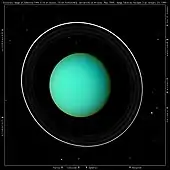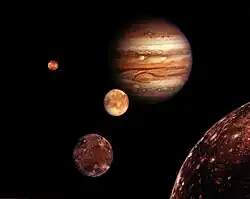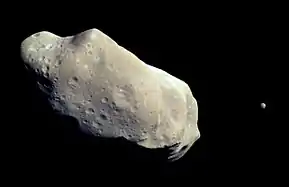Perdita (moon)
Perdita /ˈpɜːrdətə/ is an inner satellite of Uranus. Perdita's discovery was very complicated, as the first photographs of Perdita were taken by the Voyager 2 spacecraft in 1986, but it was not recognized from the photographs for more than a decade. In 1999, the moon was noticed by Erich Karkoschka and reported.[3][8] But because no further pictures could be taken to confirm its existence, it was officially demoted in 2001.[9] However, in 2003, pictures taken by the Hubble Space Telescope managed to pick up an object where Perdita was supposed to be, finally confirming its existence.[7][10]
 | |
| Discovery | |
|---|---|
| Discovered by | Erich Karkoschka / Voyager 2 |
| Discovery date | May 18, 1999 (in images dating back to January 18, 1986) |
| Designations | |
Designation | Uranus XXV |
| Pronunciation | /ˈpɜːrdətə/[1] |
| Adjectives | Perditean /pɜːrdəˈtiːən/[2] |
| Orbital characteristics | |
Mean orbit radius | 76,417 ± 1 km[3] |
| Eccentricity | 0.0012 ± 0.0005[3] |
| 0.638021 ± 0.000013 d[3] | |
| Inclination | 0.0 ± 0.3° (to Uranus' equator)[3] |
| Satellite of | Uranus |
| Physical characteristics | |
Mean radius | 13.3±0.7 km[4] |
| ~2220 km2[lower-alpha 1] | |
| Volume | ~9850 km3[lower-alpha 1] |
| Mass | ~(4.93–8.87)×1015 kg[lower-alpha 1] |
Mean density | 0.5–0.9 g/cm3[5][6] |
| ~0.002–0.003 m/s2[lower-alpha 1] | |
| ~0.007–0.009 km/s[lower-alpha 1] | |
| synchronous[3] | |
| zero[3] | |
| Albedo | 0.08 ± 0.01 (assumed)[7] |
| Temperature | ~64 K[lower-alpha 1] |
Following its discovery in 1999, it was given the temporary designation of S/1986 U 10.[8] It was named Perdita (Latin for 'lost') after the daughter of Leontes and Hermione in William Shakespeare's play The Winter's Tale. The moon is also designated Uranus XXV.[11]

The moon orbits between Belinda and Puck. The above-mentioned Hubble measurements prove that Perdita does not follow a direct Keplerian motion around Uranus. Instead, it is clearly caught in a 43:44 orbital resonance with the nearby moon Belinda, and from this resonance it has been determined that Belinda's mass is 26 times that of Perdita.[12] It is also close to an 8:7 resonance with Rosalind.[3][7]
Perdita belongs to the Portia group of satellites, which also includes Bianca, Cressida, Desdemona, Portia, Juliet, Cupid, Rosalind and Belinda.[13] These satellites have similar orbits and photometric properties.[13] Little is known about Perdita apart from its orbit,[3][7] radius of 13.3 km[4] and geometric albedo of 0.08.[13][7]
See also
Notes
- Calculated on the basis of other parameters.
References
Citations
- Benjamin Smith (1903). The Century Dictionary and Cyclopedia.
- Byrne (2008). Perdita: the literary, theatrical, scandalous life of Mary Robinson.
- Karkoschka, Voyager 2001.
- Showalter & Lissauer (2006),[7] as cited in Ćuk et al. (2022).[6]
- French & Showalter 2012.
- Ćuk et al. 2022.
- Showalter & Lissauer 2006.
- IAUC 7171.
- Foust 2001.
- IAUC 8194.
- USGS: Planet and Satellite Names and Discoverers.
- French, Robert S.; Showalter, Mark R.; de Pater, Imke; Lissauer, Jack J. (2017-10-01). Orbital and Photometric Analysis of the Inner Uranian Satellites from Hubble Images. Vol. 49. p. 214.19.
- Karkoschka, Hubble 2001.
Sources
- Karkoschka, Erich (2001). "Voyager's Eleventh Discovery of a Satellite of Uranus and Photometry and the First Size Measurements of Nine Satellites". Icarus. 151 (1): 69–77. Bibcode:2001Icar..151...69K. doi:10.1006/icar.2001.6597.
- Karkoschka, Erich (2001). "Comprehensive Photometry of the Rings and 16 Satellites of Uranus with the Hubble Space Telescope". Icarus. 151 (1): 51–68. Bibcode:2001Icar..151...51K. doi:10.1006/icar.2001.6596.
- Green, Daniel W. E. (May 18, 1999). "S/1986 U 10". IAU Circular. 7171: 1. Bibcode:1999IAUC.7171....1K. ISSN 0081-0304. Retrieved 2012-01-26.
- Foust, Jeff (December 31, 2001). "Moon of Uranus is demoted". Spaceflight Now. Retrieved 2012-01-26.
- Showalter, Mark R.; Lissauer, Jack J. (2006-02-17). "The Second Ring-Moon System of Uranus: Discovery and Dynamics". Science. 311 (5763): 973–977. Bibcode:2006Sci...311..973S. doi:10.1126/science.1122882. PMID 16373533. S2CID 13240973.
- Green, Daniel W. E. (September 3, 2003). "Satellites of Uranus". IAU Circular. 8194. ISSN 0081-0304. Retrieved 2012-01-26.
- USGS/IAU (July 21, 2006). "Planet and Satellite Names and Discoverers". Gazetteer of Planetary Nomenclature. USGS Astrogeology. Retrieved 2012-01-26.
- Ćuk, Matija; French, Robert S.; Showalter, Mark R.; Tiscareno, Matthew S.; Moutamid, Maryame El (2022-07-16). "Cupid is not Doomed Yet: On the Stability of the Inner Moons of Uranus". The Astronomical Journal. 164 (2): 38. arXiv:2205.14272. doi:10.3847/1538-3881/ac745d. ISSN 1538-3881.
- French, Robert S.; Showalter, Mark R. (August 2012). "Cupid is Doomed: An Analysis of the Stability of the Inner Uranian Satellites". Icarus. 220 (2): 911–921. arXiv:1408.2543. doi:10.1016/j.icarus.2012.06.031.
External links
- Uranus 'Loses' a Moon: The 'New' Official Moon Count of the Solar System (Archived), Melanie Melton, The Planetary Society, 20 December 2001

